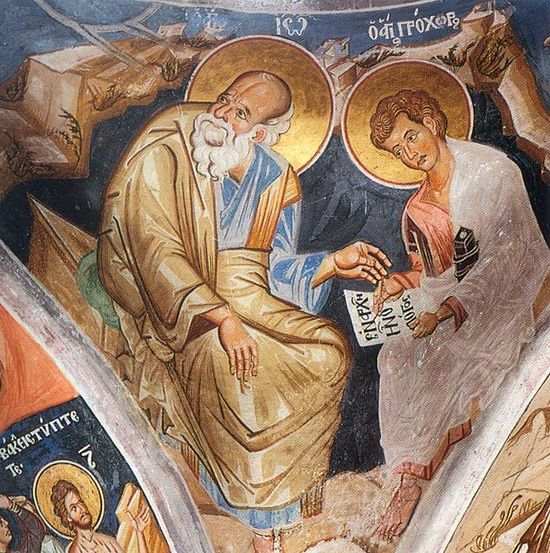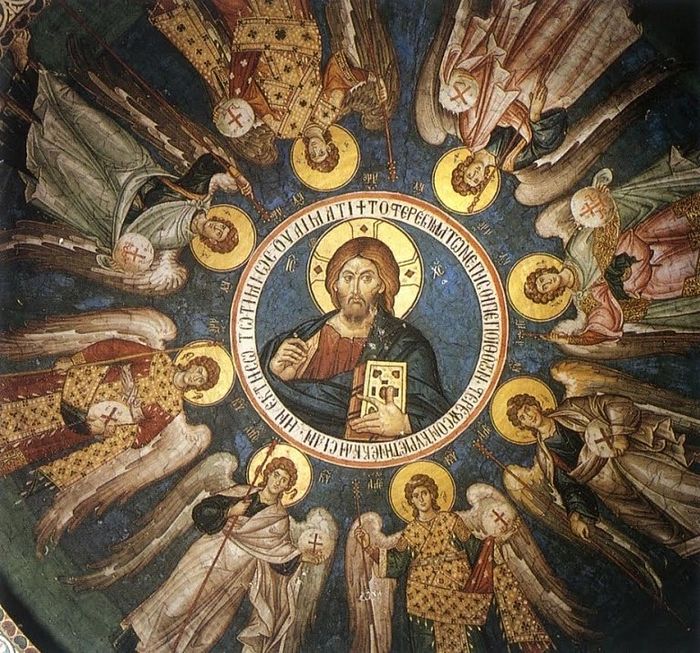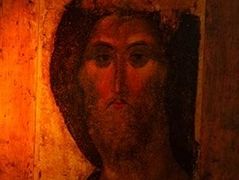Source: Pemptousia
April 25, 2016
On the occasion of the convocation of the Holy and Great Synod of the Orthodox Church, we are publishing a text by George Mantzaridis, Emeritus Professor of Theology at the Aristotle University of Thessaloniki, which deals with the manner in which Orthodox Theology is produced. This text is a contribution to the more general dialogue which is preceding the discussions of the Pan-Orthodox Synod.
* * *
Hesychasm is not merely a theological school or ecclesiastical system, but rather a phenomenon which transcends the various schools and systems. It is even more true that hesychasm is not restricted to a particular period in the history of monasticism, such as that of the fourteenth century, when the erudite monk, Barlaam the Calabrian, attacked the Athonite monks and provoked the well-known hesychast dispute. Hesychasm is the cultivation of the tranquility which is the enduring characteristic of Orthodox monasticism. But what is this tranquility and of what does it consist?
In the usual sense, ‘hesychia’ (tranquility) is equated with lack of movement, as opposed to motion; or is considered as being identifiable with rest, in contradistinction to work or occupation. In other words, tranquility is understood as an external and, in the main, a corporeal state, without any particular spiritual content or any direct connection with people’s inner life. It coincides with what the Fathers call ‘argia’ (inaction).
But in the Orthodox tradition, tranquility has a very different meaning. It does not equate to immobility, nor with rest. Nor is it treated as some sort of conventional diversion or virtue. Tranquility is the ‘most sublime insouciance’[1] and ‘the most perfect virtue’.[2] It is the path of knowledge of God, which culminates in ‘the vision of God’. The other virtues, which ‘are accomplished through work- by observing the commandments- are the first stage, and are a required condition if we are to continue our progress towards the ‘vision of God’.
Saint Symeon the New Theologian, the great hesychast saint, puts it succinctly when he says: ‘None of the apostles or the God-bearing Fathers promotes tranquility above pleasing works, but in observing the commandments they knowingly show the faith of the love of God’.[3]
Never in the life of the Church has tranquility been considered preferable to the observance of the commandments. Willful non-compliance to the commandments is the very opposite of tranquility. Because of their love for God, hesychasts faithfully observe His commandments and are thus enabled to become acquainted with Him. It is their desire to remain with Him that allows them to pass through the stage of turmoil and anxiety and to embrace the ‘divine fire’ of tranquility, so that ‘they can hear the tranquility of Christ’.[4] This is why the model of tranquility and of the hesychast life in Orthodox hesychasm is Our Most Holy Lady, who bears ‘the divine Fire’ in her arms.[5]
Through the observance of the commandments, we show our love of God and approach knowledge of Him. ‘They who have my commandments and keep them, are those who love me. And they who love me will be loved by my Father, and I will love them and manifest myself to them’.[6] But the state of prayer of the heart transcends the observance of the commandments. Whereas the observance of the commandments, which is more generally called ‘action’ in the ascetic tradition, leads to ‘contemplation’ tranquility of the mind is the locus where divine contemplation takes place.
Naturally, before people reach the level of tranquility of the mind, they have to try to concentrate their intellect, to free it from concerns and remove it from worldly cares. In this way, avoidance of the things of this world is promoted as a way of ascetic cleansing and a process of elevation towards tranquility of the mind. This is why Saint John the Sinaïte, the master of hesychasm, places renunciation as the first rung of the Ladder, his manual of hesychasm. He says that no-one will enter the heavenly bridal-chamber with a crown unless they perform the triple renunciation: of things and other people; of the severance of the personal will; and of the rejection of vainglory.[7]
The experience of tranquility of course requires external peace. It cannot be achieved in the turmoil and noise of modern life, even though there are always a few bright exceptions who manage to achieve the unachievable. Tranquility is a state of the soul, or, more accurately, of the intellect. When our intellect stops expending itself on external things and ceases to be imbued by the stimuli of this world, it comes back to itself and, through itself, ‘ascends to understanding of God’.[8] Tranquility is experienced first and foremost in the desert, and all the great hesychasts passed through the desert.
As regards the approach to God and knowledge of Him, what is usually mentioned is the verse from the Psalms ‘Be still and know that I am God’.[9] This verse is often taken as meaning external tranquility, however. In other words, stillness is considered no more than abstention from work or outward tranquility. But such a stillness, such tranquility does not have any positive content, nor, of course, does it offer any knowledge of God. ‘For knowledge of God is not given by tranquility from the outside… but rather tranquility occurs in those who have struggled legitimately and well’.[10] If people withdraw from action, that is the observance of the commandments, without investing in spiritual labor, they are lazy on both counts and so are certainly sinning.[11]
Knowledge of God does not come as the result of external tranquility, useful though this may be in its acquisition. Nor is hesychasm restricted to external tranquility. The tranquility of Orthodox hesychasm is not theoretical, but an excessively empirical state. It presupposes the observance of the commandments and the cultivation of the virtues. When ascetics mature in the ‘stadium’, in ‘action’ when, in other words, they’ve already striven ‘legitimately and well’ in the pursuit of the virtues, then they are able to turn towards contemplation. And the delight in this divine contemplation is real tranquility, the tranquility of the mind.
In presenting these two forms of the ascetic life, Saint Gregory the Theologian writes that both these forms of the ascetic life are good and beloved and people are called upon to follow the form which suits them best. Action is for most people, while contemplation is for the perfect.[12] Saint Gregory himself preferred contemplation. He was brought to this preference not so much through his own psychological make-up but rather by the divine love ‘of the good and of tranquility’ with which he was imbued.[13]
It appears that Saint Gregory’s close friend, Saint Basil the Great, preferred action. This is what he placed as the basis of the monastic life which he founded. It has been claimed, in fact, that he excluded the life of a hermit completely, as being irreconcilable to our social nature and that probably only towards the end of his life did he reluctantly accept hermits as exceptions. This view is really rather simplistic. Appearances often deceive. Basil the Great experienced tranquility intensely and noted its importance for the spiritual life. It was also the sound foundation for his unequalled pastoral and social work. How else are we to interpret his answers to the eparch Modestos, or his utter poverty after he had distributed all the worldly goods he had inherited from his parents?
Basil notes that, if our mind is distracted, ‘we cannot attain to either love of God or of our neighbor’.[14] The insistence with which he highlights the exhortation in Deuteronomy to ‘look to yourself’[15] is typical of what he has to say. In one homily with this Biblical saying as his theme, he comments: ‘Look to yourself, then; that is, neither to your family nor to those around you but to yourself alone’.[16]
Tranquility is not merely the concomitant of action, but is actually a precondition for its proper exercise. Any proper action is the fruit of tranquility. Precise observance of the double command of love assumes the unification of the fractured human persona, an ordering of the mind, and tranquility of the intellect. Basil did not encourage the establishment of centers of hermits, which would have been easy, given the number of semi-eremitic communities which the faithful had already set up in his day. He did not do so because he himself had already lived and matured in tranquility, and had been granted the vision of God, as he reveals in a letter.[17]
Basil the Great preferred the coenobitic monastery because he wished to avoid the great danger of division and complacency which an unordered life alone would imply for many people.[18] But in order to set the monastery on a sound basis and to keep open its hesychast, charismatic perspective, he also set renunciation as a condition, which he emphasized and defined as ‘the transfer of the human heart to the heavenly realm’.[19] This perspective of the monastic institution and of the Christian life in general was later developed by Basil’s actual and also spiritual brother, Saint Gregory of Nyssa, in his wonderful spiritual and hesychast writings.
From the beginning, Orthodox monasticism was hesychast. The original monks, living far from the world and practicing unceasing prayer, were, in essence, hesychasts.[20] They felt they had to have recourse to tranquility ‘in order to speak to God clearly’.[21] This was and is, however, a self-evident requirement for every real believer. And so we have tranquility as a basic characteristic of the Church’s outlook. It is the ‘good portion’ of Mary of which Christ Himself approved and which is accentuated and praised in the whole of Orthodox tradition. It also explains the familiarity which the whole of the body of the Orthodox Church has always had with the ascetic tradition, as this is presented in the Philokalia and the texts of Isaac the Syrian, Efraim the Syrian, John of the Ladder, Nikodimos the Athonite and others.
For all Christians, tranquility is a method of asceticism and a way of life. In the same ways as ethics, the spiritual life of a believer is not presented either monolithically or fragmentarily, but unfolds dynamically through self-abandonment to the will of God. In monasticism, this is achieved through obedience. Passing through the stage of purification from the passions and observance of the commandments, monastics achieve purity of the intellect and heart through obedience. In this way, they experience tranquility as a state of tranquility of the mind or of the heart. They experience it as a state of union of the intellect with the heart or as meditation on ‘the hidden person of the heart,[22] where it becomes possible to see the reflection of God’s truth. Tranquility is now no longer ascetic, but, above all, charismatic. It is a state of purity of the soul, in which people are freed of any internal disturbance and disorder, to the point where they transcend themselves and surrender to the contemplation of God. In this state of tranquility, people become transparent before God, they are known by God, because God wants them and they know God because they are conforming to His will. This is why, as Elder Sophrony writes, in this authentically charismatic life there is no asceticism.[23] In this life, the passions, against which asceticism was a necessary weapon, have already been overcome.
In the field of academic theology, the question is sometimes raised: ‘What Biblical basis is there for hesychasm. What aim does it serve and on what commandment is it based, when, as is well known, all the Gospel commandments are summed up in the double commandment of love?’
There is certainly substance to these questions, but at the same time they have remained unanswered by academic theology. There is, of course, some Biblical support for tranquility and hesychasm in the text from the Psalms: ‘Be still and know that I am God’.[24] This has been understood in a practical sense, however, without any further extension or deeper meaning. At least this was how it was understood by the Byzantine humanists who were contemporaries of Saint Symeon the New Theologian.[25] There are also practical examples from Scripture with the Prophet Elijah on Mount Carmel, John the Baptist in the desert, and Jesus Himself, Who withdrew to pray in the tranquility of the desert.[26] But even these are not thought to be sufficient to justify hesychasm. Many people believe that tranquility overlooks action. What is not so well understood, however, is that, without tranquility, action is itself undermined. Without tranquility the whole salvation of the human race is compromised, because we are not ‘saved’, but still fractured.
In general, neither cataphatic nor apophatic theology finds any real justification for tranquility and hesychasm. The answer to the question of academic theology should be sought in a kind of meta-theology, which is not unknown in the realm of the Church’s experience. Only there, where the essential relationship between tranquility and the experience of the content of Christianity can be checked and confirmed- especially the observance of the double commandment of love- can we find an answer to this question. In this way, the ascetic experience of tranquility and hesychasm offers itself as a field for the meta-theological foundation of Christian theology.
If the primary aim of theology is knowledge of God and if this occurs as a consequence of the loving communion between God and people, hesychasm with tranquility, as a practical means to and also as fruit of knowledge of God, confirms the authenticity of this knowledge of God meta-theologically, that is empirically and ontologically. The dogmas are of immeasurable depth, according the master of hesychasm, Saint John of the Ladder. The intellect of a hesychast is able to plumb these without danger. Any approach to them without previous liberation from the passions, however, is fraught with peril.[27]
This danger was also noted by Saint Gregory the Theologian.[28] Theology presupposes purity in the relationship and communion with the hypostasized Word of God. John of the Ladder makes it clear that when the senses have not been purified and united with God, ‘dialogue with God is a parlous matter’. Anyone who theologizes in such a condition ‘is stating their own conjectures’.[29] A requisite, and also an authentic state, of theology is tranquility with purity: ‘Let the work of the apprentice theologian be performed in purity’.[30] And theology as a state is experienced in mental tranquility and the tranquility of the heart. Saint Paul writes that ‘spiritual people judge all things, but are not examined by others, because they have ‘the mind of Christ’.[31] Mental tranquility clears the mind of the ascetic and allows familiarity with the mind of Christ. With this charisma, which always functions within the body of Christ, the Church, empirical theological witnesses positively to the transcendent truth of the Spirit, though always using appropriate human discourse.
It is particularly characteristic that in his discourse On Tranquility, Saint Symeon the New Theologian restricts himself almost exclusively to noting cases of people who had forgotten the world and its cares and had devoted themselves to Christ and His gifts. Thus, he mentions the harlot who washed Christ’s feet with her tears, entirely focused on Him Who could forgive her sins. He recalls the case of the three disciples who went up Mount Tabor with Christ and experienced the wonder of His Transfiguration, and also the astonishment of the Apostles who were locked in a room, ‘for fear of the Jews’ when they saw their risen Teacher, and so on.
He says that ascetics should not take these examples merely as narratives, but should see them taking place within themselves. If this does not happen and ascetics depart from the commandments and cease to do bodily works while not knowing how to work spiritually, then they fail in both areas, and sin. Those who know spiritual work well are not prevented by it from completing practical commandments through bodily effort. In fact, they probably find it easier. But if people who have confined themselves to ascetic effort, stop making any, they cannot work spiritually.[32] Saint Gregory Palamas applies the distinction between intellectual and empirical knowledge of God by the use of the terms ‘theology’ and ‘sight of God’. Saint Gregory says that theology is as far removed from the sight of God, which is effected within the light, as the knowledge of a thing is from that thing’s acquisition: ‘It is not the same for someone to speak about God and to enter into communion with Him’. Theology needs the spoken word, and even the art of speech, as it does the use of logical arguments and proofs, when we want to pass our knowledge to other people. This can be done by people with worldly wisdom, even if they are not spiritually pure. But for people to bring God into themselves and to mingle with His most pure light, insofar as this is possible for human nature, this cannot be done unless they move out of themselves, or rather surpass themselves. And this requires purification, which comes through the exercise of the virtues.[33]
This ecstatic [in the sense of transcending the self, not a paroxysm of emotion] character of the knowledge of God is entirely consonant with ecstatic nature of the Christian view of the human person. People never really fulfil their potential unless they go beyond what they are. We were not created by God to remain as we are. We were created human by nature in order to become gods by Grace. The ‘likeness of God’ is the ecstatic parameter which was given to us from the time when our nature was formed, for our completion as persons and the achievement of the aim of our existence.
The potential for ecstatic transcendence is part and parcel of human nature. Human nature is a depiction, in the image of God. This does not mean that it is not real. On the contrary it means that it is very real indeed and dynamic. To be more precise, it means that it is personal; in other words, that its reality, its truth, lies in an immediate relationship with its absolute archetype, which lies beyond its relativity. The truth of human nature is transcendental. It is linked to the real Being which it depicts.
People are both infinite and negligible. We are infinite when we remain pure and reflect within us the real Being, God. God is infinite by nature and we, His image, are infinite by Grace. But when we are sullied, i.e. darkened, we are next to nothing. We are infinitely dark and negligible because we tarnish and abrade the archetype within us, the Absolute and Infinite.
Saint Ignatios the God-Bearer writes: ‘Hesychast theology hears the ‘tranquility’ of God.[34] It carries out the work of Mary, who sat at Jesus’ feet and listened to His teaching’.[35] There is also academic theology which does the work of her sister, Martha, who was swamped with the preparations for Christ’s dinner.[36] Without Martha’s hard work, the dinner would not have been prepared. Like Mary, Martha loved Christ. He praised the attitude of Mary, however, saying that the ‘good portion’ would not be taken away from her.[37]
Academic theology has always been orientated towards the world and has been ‘cumbered about with much serving’.[38] It links theology to philology, history, philosophy, sociology and with whatever else it deems useful as a science. It frequently works with great worldly care for the preparation of the Church’s supper, sometimes, indeed, like Martha, declaring its frustration with those who have adopted the attitude of Mary, forgetting Christ’s praise of her. But although it does the work of Martha, it often filches from Mary’s portion. And this creates dangerous conditions for the Church and the faithful.
The work of academic theology is useful and important when it serves humbly, when it investigates and projects the life and tradition of the Church. But it becomes less certain, and even dangerous, when it succumbs to human self-importance and capriciousness. Of particular importance is the reduction of non-empirical theology to a dangerous form of idle talk. Saint Symeon the New Theologian notes that ‘idle talk’ is not merely ‘unprofitable talk’, as one might suppose, but talk which is formulated without empirical awareness of what is being said. When, for example, people preach contempt for worldly glory while not scorning it themselves as being harmful and depriving them of ‘the glory above’, then they are talking idly and are lying.[39]
Academic theology is founded upon knowledge. And it is correct when it is founded on correct knowledge. Empirical theology is not founded upon knowledge. Its foundation is the light. Knowledge is not light. Light, however, is knowledge.[40] Academic theology is properly grounded when it is grounded in the knowledge of light. This foundation enriches academic theology. And academic theologians are duty bound to enrich their mind and their theology with the theology of the light, which involves some form of contact with empirical theology, some kind of exercise of self-emptying and obedience, for the reception of its fruit. Without this prerequisite, academic theology becomes ‘idle talk’ or even ‘lying talk’. According to Saint Diadokhos of Fotiki "Nothing is poorer than a mind without God pondering on the things of God."[41] Finally, in noting the narrative nature of theology, Elder Sophrony writes that real theology is not the product of human reason nor the result of critical studies, but a revelation concerning that higher Being which people enter through the action of the Holy Spirit.[42] This is why the real approach to the dogmatic teaching of the Church is made through ‘anti-dogmatics’, that is, through personal experience.
Two tendencies can usually be determined within academic theology: the conservative and the progressive. ‘Conservative’ theologians, with their barren pusillanimity and sterility, ‘speak without being’. They are incapable of either promoting or hindering any movement towards the ‘divine fire’ of tranquility. ‘Progressive’ theologians, with their bold imagination and reflections, attempt to be always in ‘creative’ agreement with secular society. But in this way, real theology is neither preserved nor moved forward. The hub of the real ‘preservation’ and, at the same ‘progression’ of real theology always remains the ‘fire of tranquility’. That which is content with the attitude of Mary. The torch-bearer of this fire is Orthodox hesychasm, which has been preserved over the years and can be felt empirically in each phase of innovation in the Orthodox Church. So hesychasm remains the authentic source for any renovation in the Orthodox Church.







